GC Leong Test : The Earth's Crust - 1 - BPSC (Bihar) MCQ
10 Questions MCQ Test - GC Leong Test : The Earth's Crust - 1
Consider the following statements about the surface of the earth:
1. The upper part consists of granitic rocks and forms the continents.
2. Its main mineral constituents are silica and magnesium so it is collectively referred to as the sima.
Which of these statements is/are correct?
Consider the following statements:
1. Immediately beneath the crust or lithosphere is the mantle which is composed mainly of very dense rocks rich in olivine
2. The interior layer is the core, is made up mainly of iron with some nickel.
Which of these statements is/are correct?
Consider the following statements Igneous rocks:
1. Igneous rocks are formed by the cooling and solidification of molten rock (magma).
2. They are normally crystalline in structure.
3. They occur in strata and they contain fossils.
Which of these statements is/are correct?
Consider the following statements:
(1) Coal is a sedimentary rock.
(2) Basalt is an igneous rock.
Which of the statements given above is/are correct?
Consider the following statements about sedimentary rocks:
1. The rocks may be coarse or fine-grained, soft or hard.
2. The materials that form sedimentary rocks are only brought by streams and glaciers
Which of these statements is/are correct?
Consider the following statements:
1. Under great heat and pressure, All rocks except igneous or sedimentary may become metamorphic rocks.
2. Clay may be metamorphosed into marble.
Which of these statements is/are correct?
In the context of Fold Mountains, the stresses in the Earth's crust is due to:
1. Increased Load of the overlying Rock
2. Flow movements in the mantle
3. Expansion or contraction of some part of the earth
Which of these statements is/are correct?
Consider the following statements:
1. The overriding portion of the thrust fold is termed as overthrust fold.
2. When the crest of a fold is pushed too far, an overfold be called mountains of elevation.
Which of these statements is/are correct?
Consider the following statements regarding Faulting:
1. When the earth's crust bends, folding occurs, but when it cracks, faulting takes place.
2. Faulting can be caused only by tension.
Which of these statements is/are correct?





















